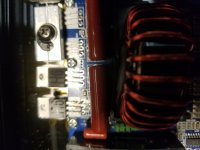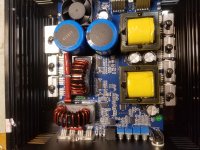Usually, this brazilian amps are available in 1 and 2 ohm version.
Usually, in 3k 1 ohm version you can fit 150v 80/100A mosfets (like IRFB4115 or IRFB4321) because, due to the low impedance capability, you must have low rail voltage and high current mosfet.
In 3k 2 ohm version you can fit 200v 70/80A mosfets (like IRFB4127 or IRFB4227) because, due to the (relatively) high impedance capability, you must have higher rail voltage with a lower current (for driving limits, because if you use a mosfet with a higher maximum voltage, you will necessarily have a lower current, otherwise the mosfet will be too heavy to drive if you choose high voltage and high current FETs).
Also, at 2ohm you can use a mosfet with higher voltage and lower current because the power will be realized with a lot of voltage and little current, due to produce the same power of the 1ohm version but at 2ohm.
This are the mosfet that i use.
Usually, in 3k 1 ohm version you can fit 150v 80/100A mosfets (like IRFB4115 or IRFB4321) because, due to the low impedance capability, you must have low rail voltage and high current mosfet.
In 3k 2 ohm version you can fit 200v 70/80A mosfets (like IRFB4127 or IRFB4227) because, due to the (relatively) high impedance capability, you must have higher rail voltage with a lower current (for driving limits, because if you use a mosfet with a higher maximum voltage, you will necessarily have a lower current, otherwise the mosfet will be too heavy to drive if you choose high voltage and high current FETs).
Also, at 2ohm you can use a mosfet with higher voltage and lower current because the power will be realized with a lot of voltage and little current, due to produce the same power of the 1ohm version but at 2ohm.
This are the mosfet that i use.
If I understand what he means, it should be LM319. In Soundigital amplifiers they are screen printed as "PROC1".Mario - do you know what IC7 is? PWM chip?
If all is working is there a way to force drive to the output fet gate with no outputs installed?
Unfortunately I don't know if there is a way to start the amplifier even without the output mosfets, I suppose that the microcontroller expects a PWM signal from the outputs to be able to correctly enable the "correct operation" state, then at power on , makes a "check", checks that the rail is generated for a good portion, if it does not, stop everything, if it does, proceed to the next step, where it checks that there is PWM at the output, if there is, it remains lit, if there is not everything stops.
What I can advise you is to install the mosfets, if the microcontroller of these Chinese clones works like the SOUNDIGITAL microcontroller, you will not burn anything, the amplifier will simply protect itself ...
Ok thanks
Not 100% sure, but i think they are CSD18502KCS
input or output i am asking about input?Austin2022, the output fets are as Lenin89 said, CSD18502KCS. In a pinch you might try IRFB4115.
- Home
- General Interest
- Car Audio
- SunDown Audio SFB-3000D

